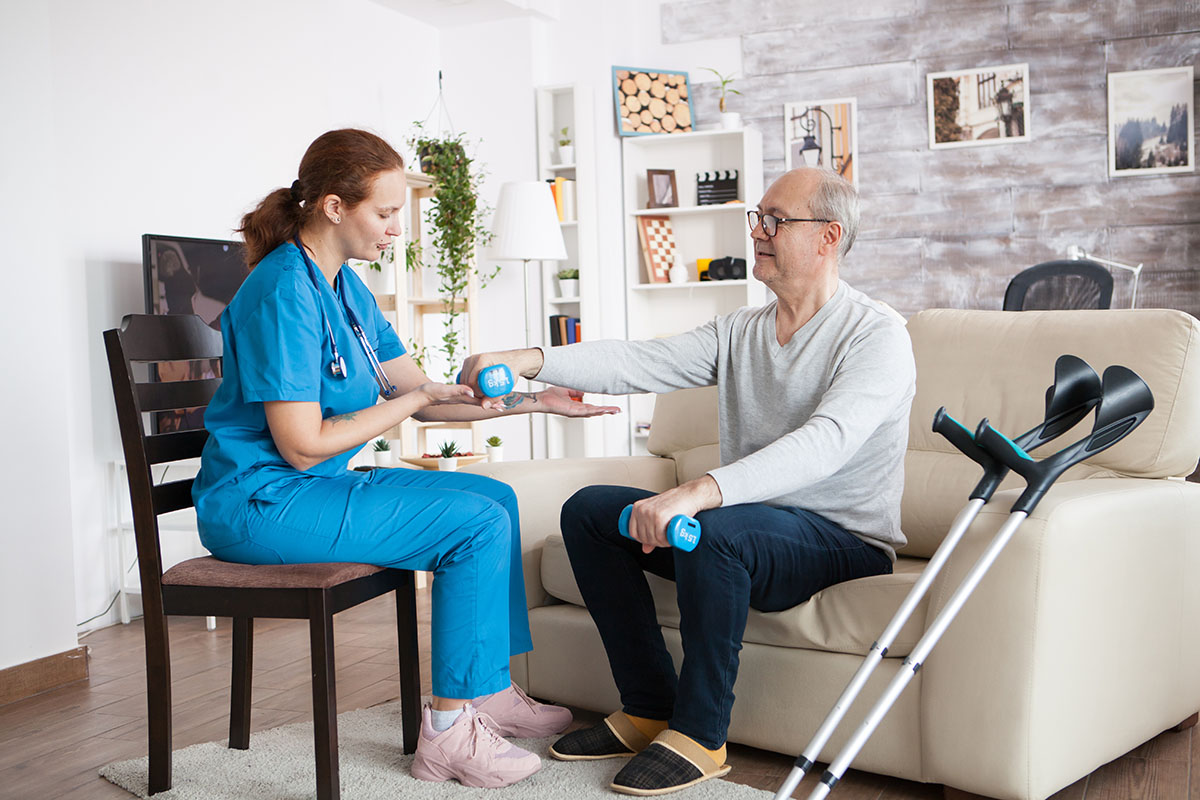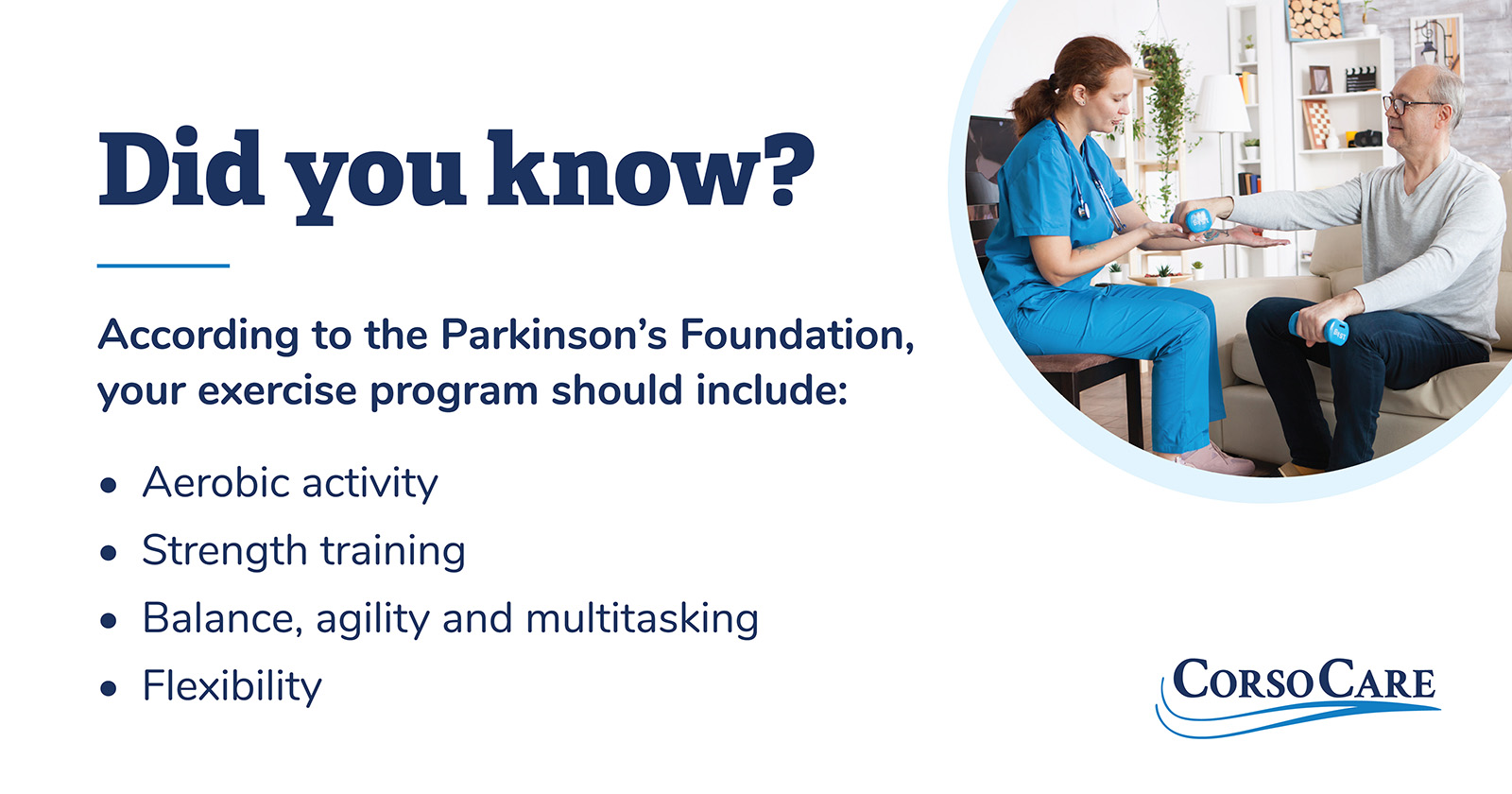
What Are The Best Exercises For Patients With Parkinson’s Disease?
“Exercise is medicine.” “The hardest part is getting started.” “Good things come to those who sweat!”
By now you’ve heard it all.
Doctors agree that exercise is key to staying healthy and that the more exercise you get, generally the better off you’ll be. For a patient with Parkinson’s disease though, exercise isn’t only good for you, it can also be a vital part of disease management.
Keep reading to discover what consistent exercises, physical therapy and occupational therapy services can do for you and your symptoms.
Why Is Exercise Important?
Parkinson’s disease is a progressive neurological disorder that causes many symptoms, some of which affect the way you move. Because of this, many people with Parkinson’s notice changes in their balance, mobility and ability to perform everyday tasks, especially in tasks that require small motor functions.
You may be thinking: If someone is experiencing physical symptoms, won’t exercise be too difficult or make their Parkinson’s symptoms worse?
That’s a common misconception. Exercise and physical activity have been shown to improve many of the symptoms associated with Parkinson’s and may even slow the progression of the disease.
According to the Parkinson’s Outcomes Project, the largest clinical study of Parkinson’s disease through the Parkinson’s Foundation’s Centers of Excellence Network, increasing physical activity to at least 2.5 hours a week has numerous benefits.
They found that consistent exercise can slow decline in quality of life by improving mobility and alleviating symptoms caused by Parkinson’s. Some other benefits include:
- Building and maintaining muscle strength and endurance.
- Improving coordination and gait disturbances, reducing the risk of falls.
- Increasing range of motion.
- Improving cardiovascular health.
- Boosting the effectiveness of common Parkinson’s disease medications.
- And more.
How Do I Exercise With Parkinson’s?
It’s possible to find exercises that you enjoy and that help improve your Parkinson’s disease symptoms. The best exercises for patients with Parkinson’s disease are fun, engaging and safe.

What exercises fit into those categories? Take a look:
Aerobic Exercise
This type of exercise is often called cardio. It includes activities of low to high intensity that raise your heart rate and breathing rate. This movement strengthens your heart, lungs and has numerous other benefits, too.
Experts recommend that Parkinson’s patients do some type of aerobic activity three days per week for at least 30 minutes.
Aerobic exercise can include:
- Walking, jogging or running.
- Swimming or water aerobics.
- Cycling or stationary biking.
- Rowing.
Strength Training
Exercises that help build muscle mass are categorized as strength training exercises. For a patient with Parkinson’s disease, strength training exercises can make it easier to perform daily activities.
Experts recommend that Parkinson’s patients do some type of strength training two to three non-consecutive days per week for at least 30 minutes.
Strength training exercises can include:
- Bicep curls.
- Tricep dips, kickbacks or extensions.
- Standard or assisted pull-ups.
- Squats or repeated stand-ups from a chair.
- Leg presses.
Balance, Agility And Multitasking Exercises
Balance and other mobility exercises are important for maintaining stability. The main goal of balance exercises is fall prevention, so be sure to speak to a doctor about what exercises are best for you.
Experts recommend that Parkinson’s patients integrate balance exercises into everyday life.
Balance exercises can include:
- Yoga or seated yoga.
- Dance classes.
- Pilates.
Flexibility Exercises
Increasing your flexibility increases your mobility, and for patients with Parkinson’s. Flexibility exercises should be a part of their daily lives.
Experts recommend that Parkinson’s patients integrate flexibility exercises into everyday life.
Flexibility exercises can include:
- Body twists.
- Wall hangs.
- Doorway bends.
- Side bends.
Benefits of Physical Therapy for Parkinson’s Patients
Did you know there are physical therapists who are specially trained to work with patients who have Parkinson’s?
A physical therapist who specializes in Parkinson’s can design an exercise routine that targets specific motor impairments. Physical therapists are also beneficial because they can provide frequent, direct feedback to help make you aware of how to exercise most effectively and safely.
Physical therapists can help you to improve:
- Balance or stability.
- Posture.
- Pain.
- Walking (slowness, small steps, or freezing).
- Moving around the house (getting up from a chair, moving around in bed).
- Getting around (in/out of a car or bus, elevators, stairs and uneven ground).
Benefits of Occupational Therapy for Parkinson’s Patients
The word “occupation” means “activity,” which can help you remember that occupational therapists focus on strategies to improve your daily activities.
Each person with Parkinson’s disease experiences symptoms differently, and they will each have individual parts of life they wish to improve. That’s the great thing about occupational therapists for people with Parkinson’s — it’s personalized to you and your needs.
An occupational therapist can help evaluate and make recommendations to improve your overall daily quality of life by:
- Focusing on exercises that use hands and fingers and both hands in a task.
- Engaging in stimulating hand exercises to help with leisure activities such as gardening or knitting.
- Helping maintain a patient’s use of toothbrushes, hairbrushes, silverware and writing tools.
